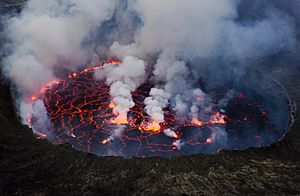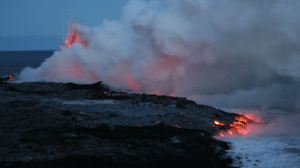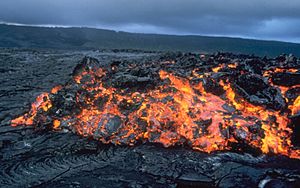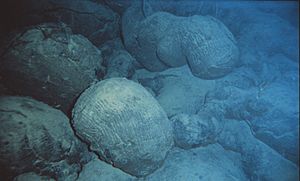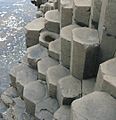Lava facts for kids
Lava is magma that flows onto Earth's surface. Think of magma as melted rock underground; when it comes out, it's called lava! Lava can be thick and slow, or thin and fast. Some types of lava, like pahoehoe and aa, are well-known for their different looks and how they flow.
Contents
How Lava Behaves
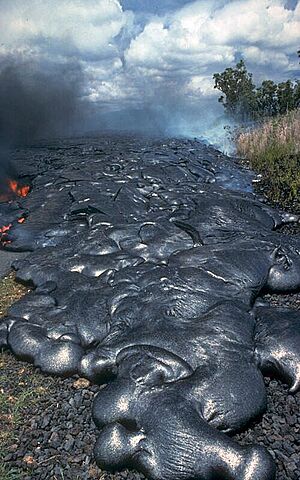
How lava acts depends mostly on what it's made of, more than how hot it is.
The thickness, or viscosity, of lava is very important.
- Thick lava (like rhyolite or dacite) moves slowly. It can clog up and form solid blocks.
- It often traps gases, which create bubbles (called vesicles) in the rock.
- Thick lava usually causes explosive eruptions, throwing out ash and rock pieces.
Thick lavas often don't flow like liquids. Instead, they can explode into ash or rock fragments. But if thick lava loses its gas or is extra hot, it might still form a flow.
Thin lava (like fresh basalt) flows easily.
- It forms puddles, channels, and even rivers of molten rock.
- Gases can easily escape from thin lava, so eruptions are usually calm.
- Volcanoes made of thin lava often form wide, gently sloped shield volcanoes instead of steep cones.
Lava can also contain other things. These include solid crystals, pieces of other rocks, and bits of older, hardened lava.
Lava flows usually move slowly, about 0.25 miles per hour (0.4 km/h). On steep slopes, they can speed up to 6–30 mph (10–48 km/h). A super fast flow of 20–60 mph (32–97 km/h) happened at Mount Nyiragongo when a lava lake collapsed.
Shapes of Lava Flows
The way lava behaves creates different shapes of lava flows and volcanoes. Thin basaltic lava often forms flat, sheet-like flows. Thick rhyolite lava forms lumpy, blocky rock masses.
Geologists can tell a lot about past eruptions by looking at the shapes of old lava flows.
A typical lava flow has a rough top layer. This can be bumpy like pillow lava, broken into pieces like ʻaʻā lava, or bubbly like scoria or pumice. The very top of the lava often looks like glass because it cools so fast when it touches air or water.
The middle of a lava flow is usually solid rock with tiny crystals. Thicker lavas often show layers from flowing and can have blocks of rock stuck inside. Crystals in the middle are usually bigger because they had more time to grow.
The bottom of a lava flow might show signs of water if it flowed over wet ground. The bottom part might have bubbles, sometimes filled with minerals. The ground underneath can look scraped, broken, or baked red if it was soil.
ʻAʻā Lava
ʻAʻā (pronounced "ah-ah") is one of the main types of lava flow. It's basaltic lava that has a rough, jagged surface made of broken lava chunks called clinker. The Hawaiian word was first used in geology by Clarence Dutton.
Walking on an ʻaʻā flow is hard because its surface is loose, broken, and sharp. The rough surface covers a solid core, which is the part that's still moving. As the thick lava in the core moves downhill, the clinkers are carried on top. At the front of an ʻaʻā flow, these cooled pieces tumble down the steep front and get buried by the advancing lava. This creates layers of broken lava both at the bottom and top of the flow.
Large lava balls, up to 3 meters (10 feet) across, are common on ʻaʻā flows. ʻAʻā lava is usually thicker than pāhoehoe lava. Pāhoehoe lava can even turn into ʻaʻā if it becomes turbulent (choppy) from hitting obstacles or flowing down steep slopes.
ʻAʻā lavas usually erupt at temperatures between 1000 to 1100°C (1832 to 2012°F).
Pāhoehoe Lava
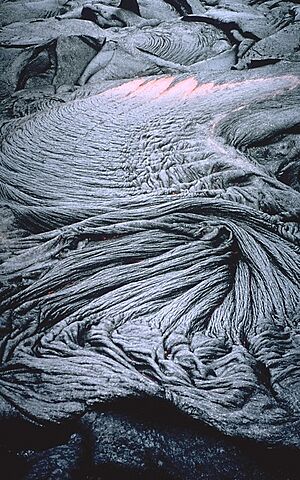
Pāhoehoe (pronounced "pah-hoy-hoy") is basaltic lava that has a smooth, wavy, or ropy surface. These smooth shapes form because very fluid lava moves under a crust that is starting to harden. This Hawaiian word was also made a geology term by Clarence Dutton.
A pāhoehoe flow usually moves forward as small blobs and "toes" that keep breaking out from the cooled crust. It also forms lava tubes. These tubes keep the lava hot and flowing easily. The surface of pāhoehoe flows can have many strange shapes, often called "lava sculpture." As pāhoehoe flows further from its source, it can become thicker and turn into ʻaʻā flows.
Pāhoehoe lavas typically erupt at temperatures between 1100 to 1200°C (2012 to 2192°F).
Most lava flows on Earth are less than 10 kilometers (6 miles) long. But some pāhoehoe flows can be more than 50 kilometers (31 miles) long!
Block Lava Flows
Block lava flows are common for andesitic lavas from stratovolcanoes (steep, cone-shaped volcanoes). They act like ʻaʻā flows, but their thicker nature means the surface is covered in smooth, angular blocks of hardened lava instead of jagged clinkers. Like ʻaʻā flows, the hot lava inside stays insulated by the blocky surface. These flows move much slower downhill and are thicker than ʻaʻā flows.
Domes and Coulées
Lava domes and coulées (pronounced "koo-lays") are formed by very thick lavas like dacite and rhyolite. Because these lavas are so thick, they don't flow far from the volcano's opening (vent). Instead, they pile up to form a lava dome right at the vent. If a dome forms on a sloped surface, it can slowly flow in short, thick streams called coulées. These flows often travel only a few kilometers from the vent.
Pillow Lava
Pillow lava is a special lava shape that forms when lava erupts underwater or flows into the ocean. It can also form when lava erupts under thick glacial ice. When the hot lava touches water, it quickly forms a solid crust. This crust then cracks, and more lava oozes out, forming new, large, rounded blobs or "pillows." Since most of Earth is covered by water, and many volcanoes are near or under water, pillow lava is very common.
Lava Landforms
Lava flows and eruptions create many unique shapes and features on the Earth's surface, from huge volcanoes to tiny rock patterns.
Volcanoes
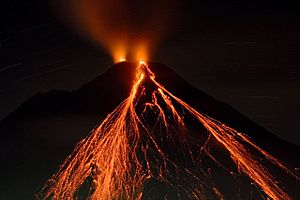
Volcanoes are the main landforms built by many eruptions of lava and ash over time. They can be:
- Shield volcanoes: These have wide, gentle slopes. They form from many calm eruptions of thin basaltic lava.
- Stratovolcanoes: Also called composite volcanoes, these are steep-sided. They are made of layers of ash and thicker lava flows.
A caldera is a large, bowl-shaped hollow that can form at the top of a stratovolcano. This happens if the magma chamber (underground lava storage) empties during a big explosive eruption. The top of the volcano then collapses inward. Calderas can sometimes have lakes or new lava domes inside them. Calderas can also form slowly without explosions, especially in shield volcanoes.
Cinder and Spatter Cones
Cinder cones and spatter cones are small hills built by lava around a small opening on a volcano. Cinder cones are made of ash and rock pieces thrown out during explosive eruptions. Spatter cones are formed by molten lava blobs and cinders that are ejected in a more liquid form.
Kīpukas
A kīpuka (pronounced "kee-poo-ka") is a Hawaiian term for an elevated area like a hill or old lava dome that is surrounded by newer lava flows. New lava flows cover the land around it, making the kīpuka look like a green island in a barren lava field.
Lava Domes
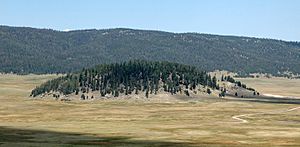
Lava domes are formed when very thick, felsic magma (a type of molten rock) is squeezed out. They can form noticeable rounded bumps, like at Valles Caldera. As a volcano pushes out this thick lava, it can build up a large, pillow-like structure. This structure cracks and may release cooled chunks of rock and rubble. The top and sides of a growing lava dome are often covered in rock fragments and ash.
Famous examples of lava dome eruptions include the Novarupta dome and the domes at Mount St. Helens.
Lava Tubes
Lava tubes form when a flow of thin lava cools on its top surface, creating a solid crust. Underneath this crust, which acts like a great insulator, the lava can keep flowing as a liquid. If this flow continues for a long time, the lava path can become a tunnel, or lava tube. These tubes can carry molten rock many kilometers from the vent without cooling much. Often, these lava tubes drain empty when the lava supply stops, leaving long, open tunnels inside the lava flow.
Lava tubes are found in modern eruptions, like at Kīlauea. Very long, open lava tubes from millions of years ago are found in North Queensland, Australia, some stretching for 15 kilometers (9 miles).
Lava Fountains
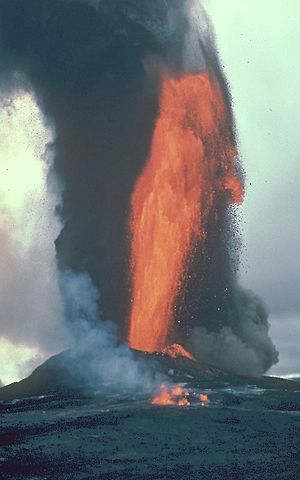
A lava fountain is when lava is forcefully, but not explosively, shot out from a volcano's opening or crack. The highest lava fountains ever recorded were during the 1999 eruption of Mount Etna in Italy, reaching heights of 2000 meters (6560 feet). However, lava fountains from Mount Vesuvius in 1779 are thought to have reached at least 3000 meters (9840 feet)! Lava fountains can be short bursts or a continuous jet of lava. They are common in Hawaiian eruptions.
Lava Lakes
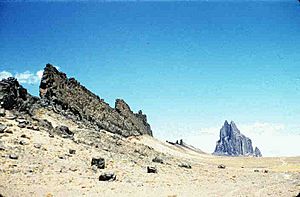
Sometimes, a volcano's crater fills with lava but doesn't erupt. This pool of lava inside the crater is called a lava lake. Lava lakes usually don't last long. They either drain back into the magma chamber or erupt as lava flows or explosions.
Only a few places in the world have permanent lava lakes. These include:
- Mount Erebus, Antarctica
- Puʻu ʻŌʻō and Halemaumau Crater on Kilauea volcano, Hawaii
- Erta Ale, Ethiopia
- Nyiragongo, Democratic Republic of Congo
- Ambrym, Vanuatu.
Lava Deltas
Lava deltas form when lava flows from land into a body of water. The lava cools and breaks apart as it hits the water. These broken pieces fill up the seafloor, allowing the lava flow on land to extend further out into the water. Lava deltas are usually formed by large, calm eruptions of basaltic lava.
Dangers of Lava
Lava flows can destroy anything in their path. However, it's rare for people to get hurt or die because lava usually moves slowly enough for everyone to escape. But sometimes, people get trapped or get too close. A very fast and dangerous event happened at Mount Nyiragongo in Zaire (now Democratic Republic of the Congo) on January 10, 1977. A wall of the crater broke, and a fluid lava lake drained out in less than an hour. The lava rushed down the steep slopes at up to 100 km/h (62 mph), covering several villages while people were asleep.
Deaths from volcanoes are often caused by other things, like:
- Volcanic ash and rocks
- Hot, fast-moving clouds of gas and ash (pyroclastic flows)
- Mudflows (lahars)
- Poisonous gases that travel ahead of the lava
- Explosions when lava touches water
Areas with recent lava flows can still be dangerous even after the lava cools. New land created by flows can be unstable and break off into the sea. Flows often crack deeply, forming dangerous holes. Falling on ʻaʻā lava is like falling on broken glass. If you cross lava flows, it's best to wear strong hiking boots, long pants, and gloves.
Trying to change the path of a lava flow is very hard. But it has been partly done, like in Vestmannaeyjar, Iceland. Scientists are still researching how to design simple, low-cost barriers to divert lava flows.
Towns Destroyed by Lava Flows

- The Nisga'a villages of Lax Ksiluux and Wii Lax K'abit in British Columbia, Canada, were destroyed by thick lava flows from Tseax Cone in the 1700s.
- Garachico on Tenerife island was destroyed in 1706 (rebuilt).
- Cagsawa, Philippines, buried by lava from Mayon Volcano in 1814.
- Keawaiki, Hawaii, 1859 (abandoned).
- San Sebastiano al Vesuvio, Italy, destroyed in 1944 by Mount Vesuvius (rebuilt).
- Koae and Kapoho, Hawaii, were both destroyed by Kīlauea in January 1960 (abandoned).
- Kalapana, Hawaii, was destroyed by the Kīlauea volcano in 1990 (abandoned).
- Kapoho, Hawaii, was mostly covered by lava in June 2018, with its neighborhood Vacationland Hawaii completely destroyed.
Towns Damaged by Lava Flows
- Catania, Italy, in the 1669 Etna eruption (rebuilt).
- Sale'aula, Samoa, by eruptions of Mt Matavanu between 1905 and 1911.
- Mascali, Italy, almost destroyed by Mount Etna in 1928 (rebuilt).
- Parícutin (village) and San Juan Parangaricutiro, Mexico, by Parícutin volcano from 1943 to 1952.
- Heimaey, Iceland, in the 1973 Eldfell eruption (rebuilt).
- Piton Sainte-Rose, Reunion island, in 1977.
- Royal Gardens, Hawaii, by Kilauea in 1986–87 (abandoned).
- Goma, Democratic Republic of Congo, in the Nyiragongo eruption in 2002.
- Los Llanos de Aridane (Todoque neighborhood) and El Paso (El Paraíso neighborhood) on La Palma in the 2021 Cumbre Vieja volcanic eruption.
Towns Destroyed by Tephra
Tephra is lava in the form of volcanic ash, small rock fragments (lapilli), or larger volcanic bombs and blocks.
- Pompeii, Italy, in the Mount Vesuvius eruption in 79 AD.
- Herculaneum, Italy, in the Mount Vesuvius eruption in 79 AD.
- Cerén, El Salvador, in the Ilopango eruption between 410 and 535 AD.
- Sumbawa Island, Indonesia, in the Mount Tambora eruption in 1815.
- Plymouth, Montserrat, in 1995. Plymouth was the capital and main port for Montserrat and had to be completely abandoned.
Images for kids
-
Stromboli eruption. The yellow/reddish things in the picture are lava.
-
Lava flow during a rift eruption at Krafla, Iceland in 1984.
-
Columnar jointing in Giant's Causeway in Northern Ireland.
-
Block lava at Fantastic Lava Beds near Cinder Cone in Lassen Volcanic National Park.
See also
 In Spanish: Lava para niños
In Spanish: Lava para niños


